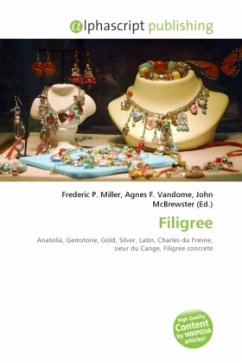Filigree (formerly written filigrann or filigrane; also known as telkari, the name given in Anatolia, meaning "wire work", and cift-isi, pronounced chift-ishi, meaning "tweezers work") is a jewel work of a delicate kind made with twisted threads usually of gold and silver or stitching of the same curvy motif. It oftens suggests lace, and is most popular in French fashion decoration from 1660 to the present. It is now exceedingly common for ajoure jewellery work to be mislabelled as filigree. While both have many open areas, filigree involves threads being soldered together to form an object and ajoure involves holes being punched, drilled, or cut through an existing piece of metal. The word, which is usually derived from the Latin filum, thread, and granum, grain, is not found in Ducange, and is indeed of modern origin. According to Prof. Skeat it is derived from the Spanish filigrana, from "filar", to spin, and grano, the grain or principal fibre of the material.
Bitte wählen Sie Ihr Anliegen aus.
Rechnungen
Retourenschein anfordern
Bestellstatus
Storno








